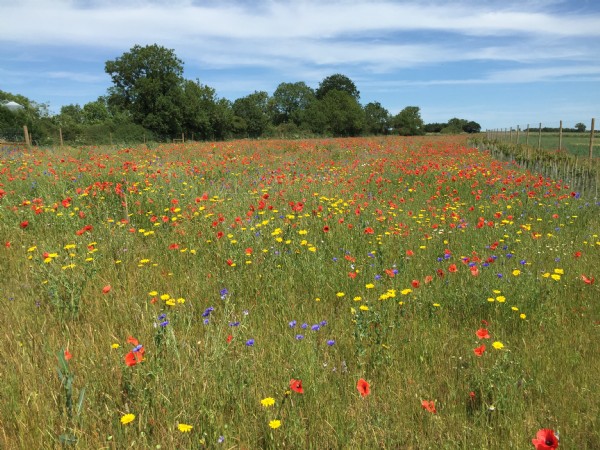

We planted a variety of crops earlier this year and it’s been encouraging to see them all growing so well.
The twelve acres of Herbal Ley we planted in May germinated slowly because it’s been so dry, but with more rain, it’s now flourishing. We ploughed and power harrowed the ground, before rolling it to consolidate the seed bed. We then lightly comb-harrowed the seedbed just before sowing to eradicate a flush of weeds, chiefly field madder and sowthistle. The seed was then spun on with a spinner and rolled the same day with a flat, heavy roll. We used Cotswold Seeds’ Mix 20 which is a deep rooting diverse ley designed to provide nutritionally balanced grazing on the light thin soil that is typical in the Cotswolds. It is usually used for rotational grasslands, with the aim to improve low organic matter, thin soils, which would then be put back into arable crops. But we’re using it to improve soil health, since it includes deep rooting grasses, legumes and forage herbs, and also so that we can study this mixture in depth. The next stages will be to graze it lightly in autumn and utilise it properly next year with mob sheep grazing.
Cotswold Seeds has been interested in sainfoin for many years. It’s a traditional Cotswold crop but it’s popularity has fallen away because of establishment issues and an intensification in agriculture, with higher inputs. Since the Honeydale soil type should be ideal for sainfoin we were keen to get a crop in. It’s been planted with companion grasses, meadow fescue and Timothy, which will help to increase the yield and reduce competition from weeds. It was sown on 4th June, which was quite late, but despite this it has established well thanks to the warmer late spring soil temperatures and is now about 6cm high, with several leaves. It will be interesting to see if it has enough time to flower this year.
Barley has been grown for many years at Honeydale so we’ve sown control plots in each of our fields this year to monitor what happens when the land is left as it was, compared to fields sown for improvement with diverse mixtures of species. Despite having had no nitrogen fertilizer, the barley is coming into ear now. We’ll be combining it ourselves later this summer..
One of the remaining fields at Honeydale has been sown with a soil improving mixture called Summer Quick Fix (mustard and clover). This is a short term crop, designed to provide green cover during summer and be incorporated during autumn, with another over-winter crop later sown to improve soil organic matter. The idea for this field is to continuously grow a variety of green crops, with the aim of stimulating the soil biota and increasing organic matter, over a number of years. We will monitor the organic matter levels as well as soil structure to see the time frame it takes to improve the health of the soil in a continuous green manure system.
In early June we sowed two mixtures of seed bearing species designed to provide overwinter food for birds. The One Year Winter Birdfood is an annual mixture, with triticale, linseed mustard, millet, fodder radish and quinoa. We’ve also planted a Two Year Wild Bird Seed mix designed to stay in the ground for longer. This contains triticale, kale, quinoa and fodder radish, which will provide food over winter. The recent rain has been very beneficial and both crops are doing well.
The hay meadow has been cut after good growth and produced 83 round bales Before cutting, we allowed all the wildflowers and grasses to go to seed to keep seeds to perpetuate growth. We spotted yellow rattle, red clover, hedge bedstraw and birdsfoot trefoil. We saw one bee orchid last year but have now counted five. The meadow will be grazed for sheep later in the autumn to tidy it up.
Date Posted: 27th July 2015



